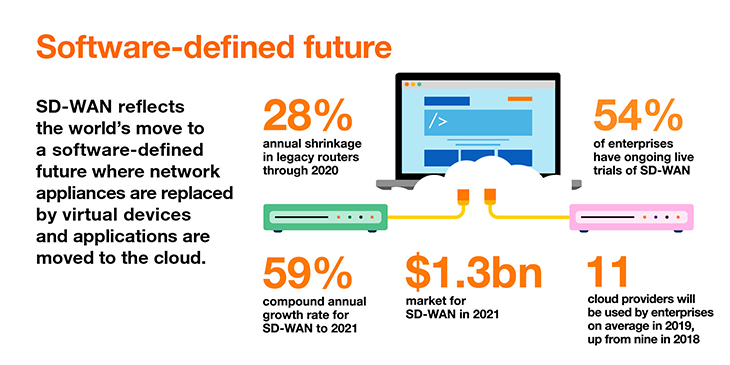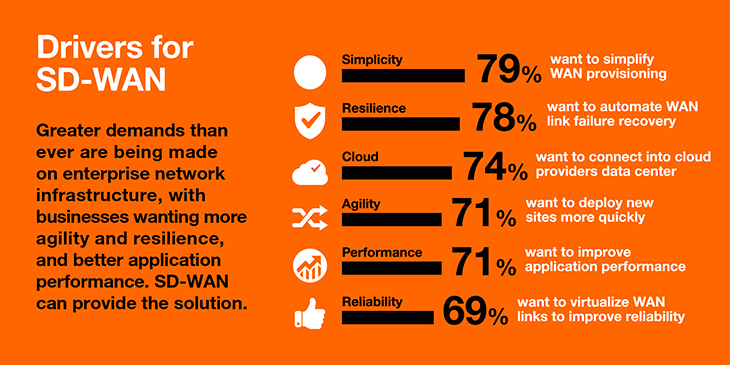The business landscape is unpredictable. Don’t let your network hold you back.
Forward-thinking organizations with multiple sites are quickly realizing the benefits that SD-WAN can offer in addressing the necessity for flexible, scalable and cost-efficient networking. Let us look at four drivers for SD-WAN that are helping enterprises get ahead of the competition.
1) Moving to the cloud
IDC estimates that global SD-WAN infrastructure and services revenues will see a compound annual growth rate of 69 percent, reaching $8 billion by 2021. This is partly fueled by enterprises migrating to the cloud and the continued rise of public, cloud-based, software-as-a-service (SaaS) applications.
According to IDC, SD-WAN is increasingly being leveraged to provide dynamic connectivity optimization and path selection in policy-driven, centrally-manageable, distributed network architectures. SD-WAN also satisfies the security demands associated with distributed and cloud-based applications through built-in capabilities – but also integration with cloud based or virtualized best-of-breed security functions.
SD-WAN is an ideal partner for SaaS. Not only does it offer reliability and quality for SaaS applications, it also provides IT departments with security and control to manage multiple applications from different service providers. Connections with trusted SaaS providers that use encrypted transmission can be sent straight across the Internet, while other Internet destinations can be secured through a cloud-based proxy, for example.
The appeal of SD-WAN is that it simplifies cloud connectivity. It is capable of automating simple tasks and coordinating complex workflows that are essential to roll out cloud-connected networks. Cloud-based SD-WAN gateways, for example, can be utilized to manage data traffic to public clouds and across hybrid clouds, which can dramatically increase business performance and agility. DevOps can also exploit the power of SD-WAN to create connectivity connections in minutes, as opposed to the weeks it can take for VPN connections.
In addition, SD-WAN continuously monitors the health of networks using metrics that analyze latency, jitter, etc., steering traffic around any congested links.

2) Cost-effective connectivity
Multinationals increasingly have offices in remote locations where connectivity is complex and expensive, creating connection issues. SD-WAN allows them to optimize their infrastructure while satisfying performance requirements.
Where traffic flows from branch offices to the cloud, SD-WAN cleverly utilizes all available network resources by dynamically sending traffic across the most suitable bandwidth option, from MPLS to public broadband. In fact, bandwidth optimization was one of the top four motivators in companies considering SD-WAN, according to IDC’s recent worldwide SD-WAN survey. The other three were consistent application security, integration with existing WANs, and improved automation and self-provisioning.
SD-WAN typically has a GUI-based central control where policies can be specified according to business needs. It is extremely fast compared to the traditional process, which requires individual devices to be configured through a command line interface, which can take hours to complete. It also avoids errors, which can be made with increasing numbers of devices. SD-WAN basically takes the network-device management away from the devices. Critical applications, for example, can easily be routed across network links that meet a certain security standard.
In addition, remote offices often lack technical expertise. The appeal of SD-WAN is that it does not require highly technical installation capabilities. A pre-configured plug-and-play box can be shipped to the site and for the most part auto-provisioned, speeding up time to market and time to revenue. Maintenance can be carried out remotely, further reducing costs.
3) Supporting mergers and acquisitions
In industries where mergers and acquisitions (M&A) happen on a regular basis, such as the chemicals, pharmaceuticals, manufacturing and logistics and transport industries, onboarding companies and dropping certain sites can be an enormous task. SD-WAN can merge multiple networks into a unified whole.
Merging networks can be done via various processes, such as using dynamic multipoint private networks, which can be a long and arduous process. SD-WAN can be leveraged to accelerate network integration, thanks to its ability to segment networks and quickly add new branches and users. Segment isolation allows enterprises to split and create virtual network segments, stating which networks can and cannot interact. This allows the acquiring company to segment and isolate data traffic from the acquired company accordingly, while retaining regulatory compliance.
SD-WAN abstracts the network into software as opposed to hardware, creating a network overlay. The SD-WAN software overlay reduces the time and effort required for reconfiguration and provides flexible WAN provisioning, which speeds up and simplifies the whole onboarding process. Confidential data traffic going backwards and forwards to public clouds can be directed to a higher level of security. The faster that networks can be merged in an M&A, the faster that business synergy is achieved.

4) A temperamental marketplace
Scalability is key in business, where markets can be fickle. This is especially true of the volatile retail sector where sales can depend on the weather, for example. Companies need the ability to scale up and down to handle customer demand. SD-WAN is capable of flexing and shifting as business demands.
Companies can add or take away additional cloud or Internet services, enabling them to trial new services, upscale and downscale and quickly expand into new locations. SD-WAN monitors network conditions on a continuous basis and automatically makes adjustments where required to make sure every user gets optimal performance.
Enterprises, however, don’t want to lose out on security at the cost of scalability. SD-WAN solutions answer this conundrum via embedded security features, such as firewalls, user identity controls and segmentation. The latter enables network administrators to limit the attack vista and contain visitor traffic where necessary. Traffic from untrustworthy or unknown websites can be diverted through a central Internet access point with a much higher level of security.
Find out more about the fundamentals of SD-WAN technology to grow your business and use your resources more efficiently.

